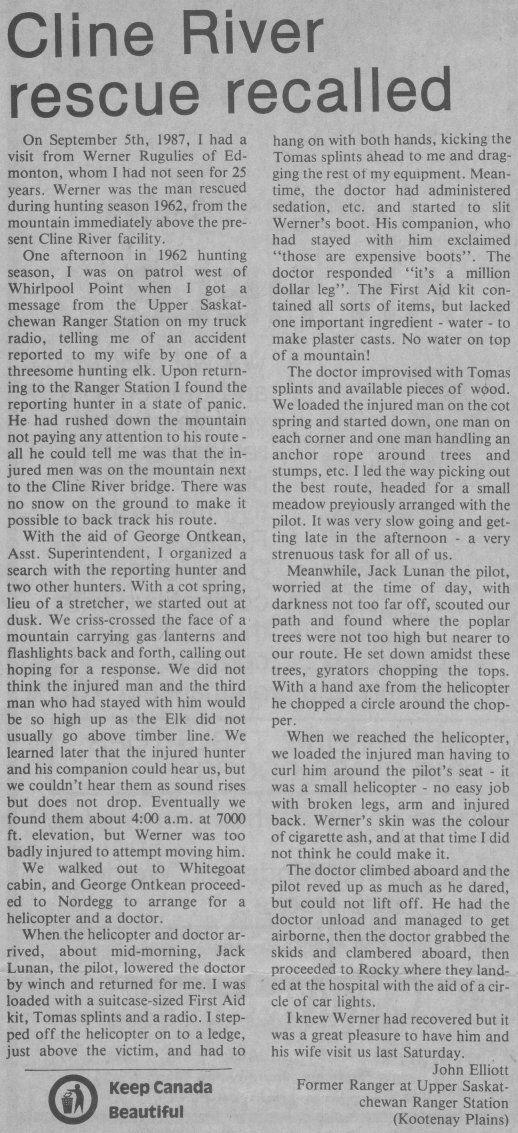
|
Source unknown. Cline River rescue recalledOn September 5th, 1987, I had a visit from Werner Rugulies of Edmonton, whom I had not seen for 25 years. Werner was the man rescued during hunting season 1962, from the mountain immediately above the present Cline River facility.One afternoon in 1962 hunting season, I was on patrol west of Whirlpool Point when I got message from the Upper Saskatchewan Ranger Station on my truck radio, telling me of an accident reported to my wife by one of a threesome hunting elk. Upon returning to the Ranger Station I found the reporting hunter in a state of panic. He had rushed down the mountain not paying any attention to his route -- all he could tell me was that the injured men was on the mountain next to the Cline River bridge. There was no snow on the ground to make it possible to back track his route. With the aid of George Ontkean, Asst. Superintendent, I organized a search with the reporting hunter and two other hunters. With a cot spring, lieu of a stretcher, we started out at dusk. We criss-crossed the face of a mountain carrying gas lanterns and flashlights back and forth, calling out hoping for a response. We did not think the injured man and the third man who had stayed with him would be so high up as the Elk did not usually go above timber line. We learned later that the injured hunter and his companion could hear us, but we couldn't hear them as sound rise but does not drop. Eventually we found them about 4:00 a.m. at 7000 ft. elevation, but Werner was too badly injured to attempt moving him. We walked out to Whitegoat cabin, and George Ontkean proceeded to Nordegg to arrange for a helicopter and a doctor. When the helicopter and doctor arrived, about mid-morning, Jack Lunan, the pilot, lowered the doctor by winch and returned for me. I was loaded with a suitcase-sized First Aid kit, Tomas splints and a radio. I stepped off the helicopter on to a ledge, just above the victim, and had to hang on with both hands, kicking the Tomas splints ahead to me and dragging the rest of my equipment. Meantime, the doctor had administered sedation, etc. and started to slit Werner's boot. His companion, who had stayed with him exclaimed "those are expensive boots". The doctor responded "it's a million dollar leg". The First Aid kit contained all sorts of items, but lacked one important ingredient - water - to make plaster casts. No water on top of a mountain! The doctor improvised with Tomas splints and available pieces of wood. We loaded the injured man on the cot spring and started down, one man on each corner and one man handling an anchor rope around trees and stumps, etc. I led the way picking out the best route, headed for a small meadow previously arranged with the pilot. It was very slow going and getting late in the afternoon - a very strenuous task for all of us. Meanwhile, Jack Lunan the pilot, worried at the time of day, with darkness not too far off, scouted our path and found where the poplar trees were not too high but nearer to our route. He set down amidst these trees, gyrators chopping the tops. With a hand axe from the helicopter he chopped a circle around the chopper. When we reached the helicopter, we loaded the injured man having to curl him around the pilot's seat - it was a small helicopter - no easy job with broken legs, arm and injured back. Werner's skin was the colour of cigarette ash, and at that time I did not think he could make it. The doctor climbed aboard and the pilot reved up as much as he dared, but could not lift off. He had the doctor unload and managed to get airborne, then the doctor grabbed the skids and clambered aboard, then proceeded to Rocky where they landed at the hospital with the aid of a circle of car lights. I knew Werner had recovered but it was a great pleasure to have him and his wife visit us last Saturday.
John Elliott |

|